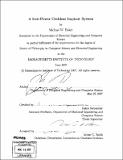A low-power cochlear implant system
Author(s)
Baker, Michael W. (Michael Warren), 1977-
DownloadFull printable version (18.46Mb)
Other Contributors
Massachusetts Institute of Technology. Dept. of Electrical Engineering and Computer Science.
Advisor
Rahul Sarpeshkar.
Terms of use
Metadata
Show full item recordAbstract
Cochlear implants, or bionic ears, restore hearing to the profoundly deaf by bypassing missing inner-ear hair cells in the cochlea and electrically stimulating the auditory nerve. For miniaturized cochlear implants, including behind-the-ear (BTE) models, power consumption is the chief factor in determining cost and patient convenience. This thesis reports on the design of a low-power bionic ear system by addressing three critical signal and power processing subsystems in low-cost CMOS ICs. First, the design of a low-power current-mode front-end for subminiature microphones demonstrates 78dB dynamic range performance with attention to RF noise and supply immunity. Second, hearing-impaired patients need strategies that decide intelligently between listening conditions in speech or noise. This work describes an automatic gain control (AGC) design which uses programmable hybrid analog-digital current-mode feedback to implement a dual-loop strategy, a well-known algorithm for speech in noisy environments. The AGC exhibits level-invariant. stability, programmable time constants and consumes less than 36pW. Third, a feedback-loop technique is explored for analyzing and designing RF power links for transcutaneous bionic ear systems. (cont.) Using feedback tools to minimize algebraic manipulations, this work demonstrates conditions for optimal voltage and power transfer functions. This theory is applied to a bionic implant system designed for load power consumptions in the 1mW - 10mW range, a low-power regime not significantly explored in prior designs. Link efficiencies of 74% and 54% at 1-mm and 10-mm coil separations, respectively, are measured, in good agreement with theoretical predictions. A full cochlear implant system with signal and power processing is explored incorporating the front-end, AGC, and RF power link, as well as analog signal processing channels. This design uses channel data to feedforward program the just-needed electrode power level. My implant system consumes 3mW of power for all audio processing and a stimulation power of 1mW. A fixed-power version of this system dissipates 2.2mW for 1mW of internal stimulation power. As many commercial systems with similar specifications consume 40mW - 80mW, this effort promises a significant reduction in cochlear implant power consumption and cost.
Description
Thesis (Ph. D.)--Massachusetts Institute of Technology, Dept. of Electrical Engineering and Computer Science, 2007. Includes bibliographical references (p. 171-179).
Date issued
2007Department
Massachusetts Institute of Technology. Department of Electrical Engineering and Computer SciencePublisher
Massachusetts Institute of Technology
Keywords
Electrical Engineering and Computer Science.